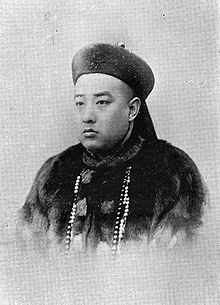Zaizhen
| Zaizhen | |
|---|---|
| Prince Qing of the First Rank | |
Aisin Gioro | |
| Father | Yikuang |
| Mother | Lady Hegiya |
| Military career | |
| Allegiance | |
| Awards | Order of the Paulownia Flowers |
| Zaizhen | |
|---|---|
Hanyu Pinyin | Qìng Qīnwáng |
| Wade–Giles | Ch'ing Chin-wang |
Zaizhen (31 March 1876 – 31 December 1947), courtesy name Yuzhou, was a Manchu prince and politician of the late Qing dynasty. Romanised forms of his name include Tsai-chen, Tsai-Chen, Tsai-Cheng.
Life and service under the Qing dynasty

Zaizhen was born in the
In 1902, Zaizhen represented the Qing Empire on a diplomatic trip to Great Britain to witness the coronation of King Edward VII. He also visited France, Belgium, Japan and the United States. In 1903, he travelled to Japan to attend the fifth Kangyō Exhibition (勸業博覽會). After returning to China, he actively advocated government reforms and requested for a Ministry of Commerce (商部) to be established. The Qing government approved his request and appointed him as the shangshu (尚書; Secretary) of the ministry. Zaizhen also concurrently held the following appointments: dutong (都統; commander) of the Bordered Blue Banner; yuqian dachen (御前大臣; a senior minister reporting directly to the emperor); zong zuzhang (總族長; clan chief) of the Plain White Banner; head of the Firearms Battalion (火器營).
In 1906, after the Qing government introduced some reforms, Zaizhen, then 30 years old, was appointed as shangshu (尚書; Secretary) of the Ministry of Agriculture, Industry and Commerce (農工商部). His portrait appears on notes issued by The Sin Chun Bank (華商上海信成銀行) in 1907.[1] A year later, the Guangxu Emperor sent him to Hangzhou to supervise the education system there. Along the way, he passed by Shanghai, where he accepted bribes from an official, Duan Zhigui, in return for helping Duan secure the position of xunfu (Provincial Governor) of Heilongjiang. He also had an affair with Yang Cuixi (楊翠喜), a singer-prostitute presented to him by Duan Zhigui. Zhao Qilin (趙啟霖), an Inspector-Official (御史), wrote a memorial to the imperial court to accuse Zaizhen of corruption. The incident caused an uproar in the imperial court, which ordered an investigation. However, due to "lack of concrete evidence", the case was closed. Zhao Qilin was charged with making a false report and dismissed from office.
In 1911, Zaizhen was appointed as a guwen dachen (顧問大臣; consultant minister) in the Bideyuan (弼德院; a government body established in May 1911 which provided advice to the emperor). His father,
Life after the Qing dynasty
Zaizhen fled to
In 1924, after
Zaizhen died in Shanghai in 1947.
Family
Parents
- Father: Yikuang, posthumously known as "Prince Qingmi of the First Rank"
- Mother: Secondary Consort, of the Hegiya clan (大側福晉合佳氏)
Consort and issue
- Primary Consort, of the Socoro clan (嫡福晉索綽羅氏)
- Puzhong (溥鐘; b. 1898 - d. ?), married a daughter of Grand Secretary (大學士) Natong (那桐)., first son
- Purui (溥銳; b. 1899 - d. ? ), married another of Natong's daughters, second son
- Pujun (溥鈞), married a woman of the Erdet (鄂爾德特) clan who was a daughter of Duangong (端恭) and younger sister of Wenxiu, third son
- Secondary Consort, of the Fuca clan (侧福晋富察氏)
- Pugang (溥钢, b. 1928- d. ?), fourth son
- Secondary Consort, of the Konggiya clan (側福晉孔佳氏)
- Secondary Consort, of the Migiya clan (側福晉米佳氏)
- Secondary Consort, of the Ninggiya clan (福晉甯佳氏)
See also
- Royal and noble ranks of the Qing dynasty
- Ranks of imperial consorts in China#Qing
References
- ^ Portraits on Chinese banknotes (1): Zaizhen (Tsai Chen).https://chinesemoneymatters.wordpress.com/2017/05/05/portraits-on-chinese-banknotes-1-zaizhen-tsai-chen/
- ^ See the gifts from China in the Royal Collection.https://www.royalcollection.org.uk/search/site/tsai-chen
- Zhao, Erxun (1928). Draft History of Qing (Qing Shi Gao). Vol. 221. China.
{{cite book}}: CS1 maint: location missing publisher (link)
